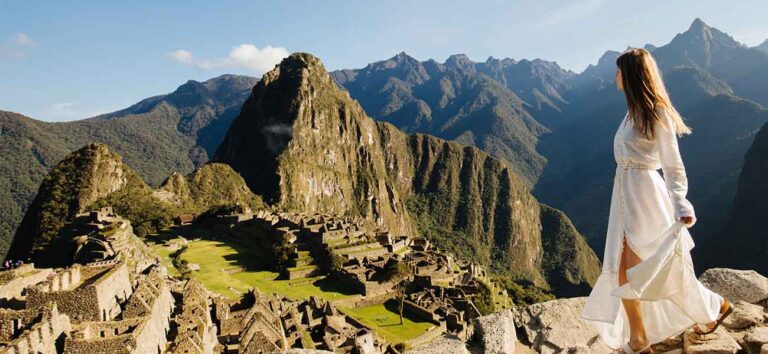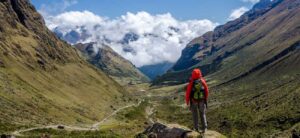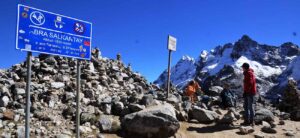Weather on the Salkantay Trek: What to Expect
The Salkantay Trek takes you through a variety of climates, from high Andean mountain passes to lush cloud forests. Weather conditions can change quickly, so it’s essential to be prepared.
At higher altitudes, especially near the Salkantay Pass (4,630 meters / 15,190 feet), temperatures can drop below freezing at night, particularly during the dry season (May to September). Days are usually sunny and clear, but it can get very cold once the sun sets.
In contrast, the lower sections of the trek, closer to the jungle and Hidroelectrica, are much warmer and more humid. Daytime temperatures can range from 20°C to 25°C (68°F to 77°F), with occasional rain even in the dry season.
The rainy season (November to March) brings frequent showers, muddy trails, and limited visibility in the mountains. While the trek is still possible during this time, it requires waterproof gear and extra caution.
No matter the season, layering is key. Be sure to pack for both cold mountain nights and warm, humid days to stay comfortable throughout the trek.
Salkantay Trekking – Frequently Asked Questions
What is the Salkantay trekking route?
The Salkantay trekking route is a popular alternative trail to Machu Picchu, passing through diverse landscapes such as mountains, cloud forests, and jungle.
How difficult is the Salkantay trek?
The Salkantay trek is considered moderately to challenging. It requires good physical condition due to high altitudes and long walking distances.
How many days does the Salkantay trek take?
Most Salkantay treks last between 4 to 5 days, depending on the itinerary and pace.
Do I need a permit for the Salkantay trekking?
No special permit is needed for the Salkantay trek itself, but you do need a ticket to enter Machu Picchu.
What is the highest point on the Salkantay trek?
The highest point is the Salkantay Pass at 4,650 meters (15,255 feet) above sea level.
What should I pack for the Salkantay trekking?
Essential items include trekking boots, warm clothes, rain gear, a sleeping bag, sunscreen, a hat, and water purification tablets.
When is the best time to do the Salkantay trek?
The best months are from April to October, during the dry season in the Andes.
Is altitude sickness a problem on the Salkantay trek?
Yes, altitude sickness can be an issue. It’s recommended to acclimatize in Cusco for at least 2–3 days before starting the trek.
Are there guided tours for Salkantay trekking?
Yes, there are many guided tours available that include meals, transportation, camping equipment, and experienced guides.
Can beginners do the Salkantay trek?
Yes, beginners can complete the trek with preparation and determination, but a good fitness level and some prior hiking experience are recommended.
Machu Picchu By Car (All Inclusive) Amazon Route
Experience the magic of Machu Picchu by car all included, the ideal option for travelers seeking a complete, safe, and budget-friendly adventure. This all-inclusive package covers transportation from Cusco to Hidroelectrica in comfortable vehicles, meals along the way, accommodation in Aguas Calientes, and entrance to the Inca citadel. You’ll also have a professional guide and personalized assistance throughout the journey. Traveling to Machu Picchu by car allows you to enjoy stunning landscapes and a more adventurous route—without worrying about logistics. Everything is taken care of for you!
You must be interested
- Salkantay Trek to Machu Picchu
- Salkantay Trail 5 days 4 nights
- Salkantay Trek difficulty level
- Salkantay vs Inca Trail comparison
- Best time to hike Salkantay Peru
- Salkantay Trek tour price 2026
- Guided Salkantay Trek packages
- Salkantay Trek altitude and acclimatization
- Salkantay Trekking tours from Cusco
- Salkantay Trek full itinerary
Salkantay Travel Information
- Salkantay Trek Food: What You’ll Eat on the Trail
- Birds of the Salkantay Trek: Species You Can Spot on the Route
- Is the Salkantay Trek Dangerous?
- Salkantay Trek Altitude: Heights Along the Route
- Flora and Fauna in Salkantay Trek
- Altitude Sickness on the Salkantay Trek
- Salkantay Trek Difficulty: How Hard Is the Route?
- Salkantay Trek FAQs: Answers to Common Questions
- Best Time to do Salkantay trek
- Training for Salkantay Trek: How to Get Ready
- How long is the Salkantay Trek?
- Salkantay Trek Price: How Much Does It Cost?
- What Is the Salkantay Trek?
- What to Bring on the Salkantay Trek?
- Best Time to Do Salkantay Trek
- Your Insider’s Guide to Salkantay Trek
- Where is Salkantay?
- Salkantay highlights
- Tour Montaña de Colores con Transporte










